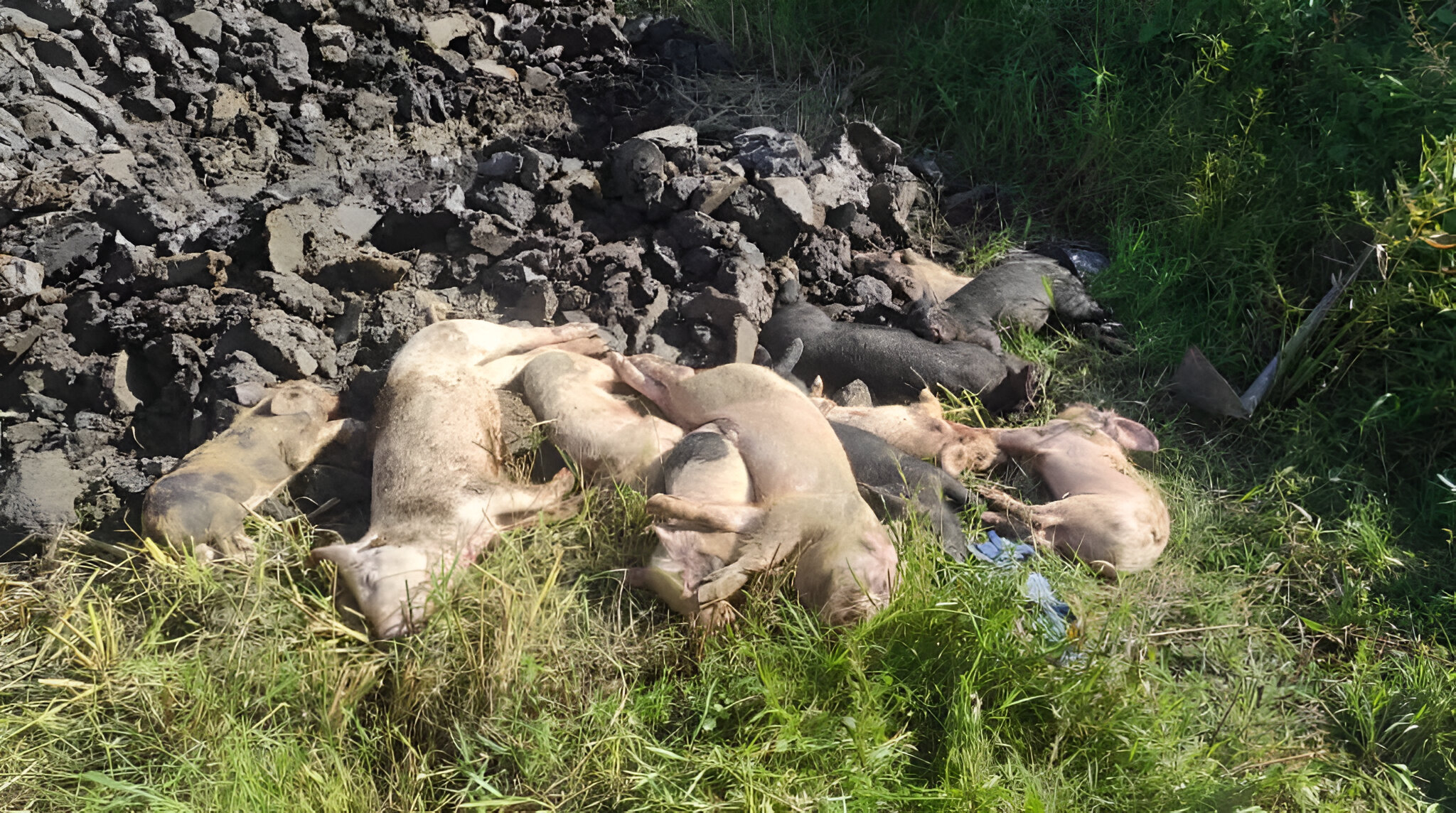Manipur Centre Grants Rs 1 Crore Relief for ASF-Hit Farmers: A Beacon of Hope for the Agricultural Community
Summary
In a significant move to support the local agricultural community, the Manipur Centre has announced a relief package of Rs 1 Crore for farmers impacted by African Swine Fever (ASF). This initiative aims to alleviate the financial strain on ASF-hit farmers, bolster recovery efforts, and set the stage for sustainable growth in the region’s agricultural sector. By providing timely financial assistance, the government is not only addressing immediate economic hardships but also paving the way for long-term resilience and development among the farming communities in Manipur.
Introduction
Imagine waking up one day to discover that the source of your livelihood is in jeopardy. For many farmers in Manipur, this has become a harsh reality due to the devastating impacts of African Swine Fever (ASF). Recently, the Centre stepped in with a lifeline—a Rs 1 Crore relief package designed specifically for those hit hardest by the outbreak. In this article, we’re going to dive deep into this critical development, explore its significance, and examine how it could change the lives of countless farmers in the region.
If you’re curious about how government relief packages work or why ASF has been such a disruptive force in agriculture, you’re in the right place. Let’s take a closer look at what this relief package means, the challenges farmers face, and the broader implications for the agricultural community in Manipur.
Understanding ASF and Its Impact on Farmers
African Swine Fever (ASF) isn’t just another headline—it’s a formidable threat that has turned the agricultural landscape upside down. ASF is a highly contagious viral disease affecting pigs, with mortality rates that can soar close to 100%. While it doesn’t pose any risk to human health, its economic impact is nothing short of catastrophic. For farmers, especially those whose livelihood depends on pig rearing, ASF can wipe out entire herds in a matter of days.
Why is ASF so devastating? Think of it like a wildfire in a dry forest. Once it starts, it spreads rapidly and leaves destruction in its wake. For farmers, each loss translates to not only a loss of income but also a blow to their future stability. The ripple effects can be far-reaching—impacting local markets, disrupting supply chains, and even shaking consumer confidence in pork products. With such high stakes, the government’s intervention becomes absolutely crucial.
The Relief Package: Details and Significance
Now, let’s break down the relief package itself. The Rs 1 Crore grant is more than just a financial bailout; it represents a comprehensive effort to cushion farmers from the worst effects of ASF. This package is designed to help those who have seen their investments, hard work, and future prospects jeopardized by an outbreak they never saw coming.
Here’s what makes this relief package stand out:
- Immediate Financial Support: The Rs 1 Crore infusion is aimed at providing quick relief to farmers grappling with losses. It ensures that they have the necessary funds to cover immediate expenses, be it medical care for their livestock, re-stocking, or even everyday living costs.
- Rebuilding Trust: Beyond the monetary value, the relief package sends a powerful message that the government is committed to supporting its farming communities. This gesture can restore faith among farmers who might feel abandoned in times of crisis.
- Economic Stimulus: When farmers receive financial assistance, they’re more likely to reinvest in their operations. This means better practices, improved biosecurity measures, and a gradual recovery of the agricultural sector.
- Long-Term Resilience: Relief packages like these are often the first step in a broader strategy to enhance the resilience of the agricultural sector. By stabilizing the immediate situation, the government can then focus on long-term measures to prevent future outbreaks and support sustainable farming practices.
Imagine a farmer who has worked tirelessly for years, only to see his entire herd decimated by ASF. This relief not only helps him cover his losses but also gives him the hope and resources to rebuild. It’s a lifeline thrown at a time when every penny counts.
Voices from the Field: Farmer Experiences
Let’s step into the shoes of the farmers for a moment. Picture an early morning on a modest farm in Manipur. The chirping of birds, the rustle of leaves, and the familiar sounds of daily routines suddenly turn into silence after the ASF outbreak. For many, the devastation is not just about lost livestock—it’s about lost dreams, lost income, and a shattered way of life.
Many farmers have shared how the ASF outbreak has left them feeling vulnerable and overwhelmed. One farmer, with years of experience in pig rearing, expressed his relief at the Centre’s intervention, saying, “This support means everything to us. It’s like a beacon of hope in our darkest hour.” Such sentiments highlight the emotional and financial toll the outbreak has taken and underscore why this relief package is so timely and necessary.
The government’s decision to allocate Rs 1 Crore for ASF-hit farmers is a step towards mending these broken spirits. It’s a reminder that while nature can be unpredictable and harsh, there are always people ready to lend a helping hand. The collective voices of the farming community are now echoing with a renewed sense of optimism—a feeling that perhaps, just perhaps, they’re not alone in this struggle.
Government’s Role and the Way Forward
The role of the government in times of crisis cannot be overstated. In Manipur, the Centre’s decision to grant Rs 1 Crore in relief funds is a clear demonstration of its commitment to the welfare of its citizens, particularly those in vulnerable sectors like agriculture. But what does this relief really mean from an administrative perspective?
First, it signifies a proactive approach to disaster management. Governments around the world have often been criticized for reactive measures, but in this case, the swift allocation of funds suggests that policymakers are listening and acting. This is a crucial point—when you feel supported by your government, you’re more likely to take positive steps towards recovery.
Second, the relief package is part of a broader strategy to fortify the agricultural sector against future crises. By providing immediate financial relief, the government is giving farmers the breathing room they need to stabilize their operations. But it’s not just about quick fixes; it’s also about long-term planning. Future measures could include enhanced biosecurity protocols, better insurance schemes, and even research into disease-resistant livestock breeds.
Think of it like reinforcing the foundations of a house. When a natural calamity hits, the immediate goal is to prevent further damage. But once the immediate threat is mitigated, the next step is to rebuild stronger and more resilient structures. The Rs 1 Crore relief package is that first, critical step towards building a more robust agricultural ecosystem in Manipur.
Economic Impact and Future Prospects
When farmers receive a much-needed financial boost, the positive effects ripple out into the broader economy. Agriculture is not just about producing food; it’s the lifeblood of many rural communities. When farmers thrive, local markets flourish, supply chains stabilize, and the overall economic environment becomes more vibrant.
In the case of Manipur, where many farmers are still recovering from the economic shocks of ASF, this relief package is a game-changer. It’s like adding a fresh coat of paint to a tired, old barn—it revives hope and opens up possibilities for improvement and growth. With the immediate financial burden alleviated, farmers can now focus on rebuilding their herds, investing in better technology, and exploring new ways to enhance their productivity.
Moreover, the infusion of funds can help kick-start ancillary businesses that rely on agriculture. Local vendors, feed suppliers, veterinary services, and transportation networks all benefit when farmers have the means to recover. It’s a classic example of how targeted government intervention can have a multiplier effect across the economy.
As we look to the future, the key will be sustainability. Relief packages are critical in moments of crisis, but long-term success will depend on the ability to adapt and innovate. With the Centre’s support, farmers in Manipur have the opportunity to modernize their practices, embrace new technologies, and even explore alternative income streams. In doing so, they can build a more resilient and diversified agricultural sector that’s better prepared for future challenges.
Challenges Faced by ASF-Affected Farmers
While the relief package is a significant step forward, it’s important to acknowledge that the road to recovery is riddled with challenges. ASF has left deep scars, and the farmers affected by the outbreak face a host of issues that extend beyond financial losses.
1. Loss of Livelihood:
For many farmers, pig rearing isn’t just a business—it’s a way of life. The sudden loss of their livestock means not only a loss of income but also the erosion of a legacy built over generations.
2. Psychological Impact:
Imagine the emotional toll of watching something you’ve nurtured for years disappear overnight. The stress and anxiety that come with such a loss can be overwhelming and may even affect family dynamics and mental health.
3. Limited Resources:
Many farmers operate on tight margins, and the financial cushion available to them is minimal. Even with the relief package, rebuilding an entire livelihood requires resources—be it money, time, or expertise—that are often in short supply.
4. Lack of Access to Modern Techniques:
In today’s world, modern agricultural practices and biosecurity measures can make a significant difference in preventing future outbreaks. However, many small-scale farmers lack access to the latest technology and training that could help them safeguard against diseases like ASF.
5. Market Instability:
After a crisis like ASF, consumer confidence can dip, and market prices may fluctuate wildly. This instability makes it difficult for farmers to plan for the future or secure fair prices for their products.
These challenges remind us that while a Rs 1 Crore relief package is a wonderful start, sustained support and comprehensive strategies are needed to address the multifaceted nature of agricultural recovery.
Community and Social Support
One of the most heartening aspects of this relief initiative is the demonstration of community solidarity. When individual farmers face hardships, the collective support of the community can make all the difference. In Manipur, local organizations, non-governmental organizations (NGOs), and even neighboring farmers have come together to share resources, information, and emotional support.
Communities have often been the unsung heroes in times of crisis. Think of them as a tightly woven net that catches those who might otherwise fall through the cracks. Local support groups, cooperative societies, and agricultural extension services are stepping in to offer guidance on modern farming techniques, alternative income sources, and ways to improve biosecurity measures. This collaborative spirit is exactly what’s needed to turn the tide against ASF.
Moreover, social support extends beyond practical help—it’s about restoring hope and building resilience. When farmers see their neighbors, local leaders, and even government officials standing in solidarity with them, it sends a powerful message: “We’re in this together.” This unity can be a catalyst for broader social change, leading to improved community infrastructure, better access to education, and a more empowered citizenry.
Long-Term Strategies to Combat ASF
While immediate relief is crucial, preventing a recurrence of ASF demands long-term strategies. What are some of the ways the government and the agricultural community can safeguard against future outbreaks?
1. Enhanced Biosecurity Measures:
Investing in biosecurity is like installing a robust security system in your home. Simple measures such as regular disinfection, controlled access to farms, and proper waste disposal can go a long way in preventing disease spread.
2. Modernizing Farming Practices:
Embracing modern technology can revolutionize how farmers manage their operations. From automated monitoring systems to real-time data analytics, modern tools can help in early detection and prompt response to any disease outbreak.
3. Research and Development:
Supporting research into ASF and its effects on livestock is crucial. Government grants and collaborations with academic institutions can lead to innovative solutions—such as disease-resistant breeds or improved vaccines—that protect farmers in the long run.
4. Training and Education:
Knowledge is power. Regular training sessions and workshops for farmers can equip them with the skills and information needed to implement preventive measures. Informed farmers are better prepared to handle crises and mitigate risks.
5. Strengthening Supply Chains:
Building resilient supply chains ensures that even if one link is disrupted, the overall system remains robust. This might include diversified sourcing, establishing local markets, and creating contingency plans for supply shortages.
These strategies are akin to building a fortress around the agricultural community. Each measure strengthens the overall defense mechanism, ensuring that farmers are better equipped to fend off not just ASF but any future challenges that may come their way.
Economic Recovery and the Ripple Effect
The Rs 1 Crore relief package is not just about patching up a crisis—it’s about setting the stage for long-term economic recovery. When farmers receive support during difficult times, they’re more likely to reinvest in their businesses, adopt better practices, and even explore new avenues for growth. This reinvestment can lead to a domino effect throughout the local economy.
For example, a revitalized farming sector can lead to increased demand for agricultural inputs such as feed, veterinary services, and farming equipment. Local businesses benefit from a surge in activity, and communities as a whole experience a boost in economic vitality. The ripple effect is comparable to dropping a stone into a pond—the initial splash may be small, but the resulting waves extend far and wide.
Moreover, when the agricultural sector stabilizes, consumer confidence tends to rebound. People feel more secure about the availability and quality of local produce, which in turn fuels demand. This positive feedback loop can create a more vibrant, self-sustaining local economy that’s resilient in the face of future challenges.
Innovations in Agriculture: A Silver Lining
Every cloud has a silver lining, and the current situation is no exception. The adversity brought about by ASF has also spurred innovation among farmers and agricultural experts alike. Many are now exploring alternative practices that can minimize risks and maximize returns. For instance, some farmers are diversifying into organic farming, which not only caters to growing consumer demand but also promotes sustainable practices.
Other innovative approaches include the use of digital tools for farm management. Mobile apps, remote monitoring, and even drone technology are being introduced to help farmers keep track of their livestock and ensure that any signs of disease are detected early. These advancements are transforming traditional practices, making them more efficient and resilient. In a way, ASF has inadvertently catalyzed a shift towards modernization—a trend that could redefine the future of agriculture in Manipur.
Conclusion
The announcement of a Rs 1 Crore relief package by the Manipur Centre is a monumental step towards healing a community battered by the ravages of ASF. This initiative not only offers immediate financial relief but also lays the foundation for a robust and resilient agricultural future. The story of these farmers is one of struggle, hope, and ultimately, renewal.
By providing this support, the government has shown that it stands with its people in times of crisis. It’s a reminder that even in the face of overwhelming challenges, collective efforts and timely interventions can spark positive change. As we look ahead, it is clear that sustainable recovery lies in the synergy between government support, community solidarity, and the relentless spirit of the farmers.
For every farmer picking up the pieces, this relief package is a beacon of hope—a sign that brighter days are ahead. And while the journey to full recovery may be long and fraught with challenges, one thing is certain: when communities unite, no hurdle is too high to overcome.
Frequently Asked Questions (FAQs)
- What is African Swine Fever (ASF) and why is it so devastating for farmers?
African Swine Fever is a highly contagious viral disease affecting pigs, with nearly 100% mortality rates in infected herds. While it doesn’t impact human health, it causes massive economic losses for farmers by wiping out livestock, leading to financial instability and long-term livelihood challenges. - How does the Rs 1 Crore relief package help ASF-hit farmers in Manipur?
The relief package provides immediate financial assistance to cover losses, rebuild operations, and support farmers through the crisis. It also helps restore confidence, stimulate local economic activity, and serves as a stepping stone for long-term recovery strategies in the agricultural sector. - What measures are being taken to prevent future outbreaks of ASF?
Long-term strategies include enhancing biosecurity measures, modernizing farming practices, investing in research and development, providing training to farmers, and strengthening supply chains. These initiatives aim to build a resilient agricultural ecosystem that can withstand future challenges. - How does community support contribute to the recovery of ASF-hit farmers?
Community support plays a crucial role by providing practical assistance, emotional encouragement, and access to local resources and knowledge. When local organizations, NGOs, and neighbors come together, they create a safety net that helps farmers recover and rebuild more effectively. - What are the future prospects for agriculture in Manipur following this relief initiative?
With the immediate financial strain eased, farmers can reinvest in their operations, adopt modern technologies, and explore diversified farming methods. This not only revitalizes the local agricultural economy but also builds long-term resilience against potential future outbreaks or economic disruptions.



